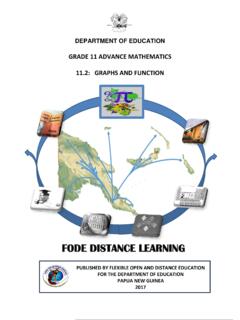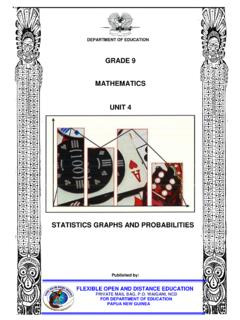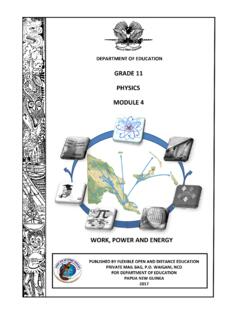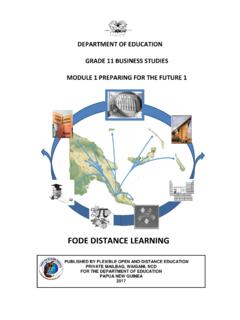Transcription of GRADE 9 SCIENCE UNIT 5 - FODE | Home
1 DEPARTMENT OF EDUCATION ELECTRICITY GRADE 9 SCIENCE UNIT 5 PUBLISHED BY FLEXIBLE OPEN AND DISTANCE EDUCATION FOR THE DEPARTMENT OF EDUCATION PAPUA NEW GUINEA 207 Writer Nieves Celmar Content and Language Editors Subject Content Adviser SCIENCE Department Subject Review Committee Course Format Editor Anna Liza Cale GR 9 SCI U5 1 TITLE GRADE 9 SCIENCE UNIT 5 ELECTRICITY IN THIS UNIT YOU WILL LEARN ABOUT: TOPIC 1: TYPES OF ELECTRICITY TOPIC 2: ELECTRIC CIRCUITS TOPIC 3: USES OF ELECTRICITY TOPIC 4: GENERATING ELECTRICITY GR 9 SCI U5 2 ACKNOWLEDGMENTS & ISBN Flexible Open and Distance Education Papua New Guinea Published in 2017 by Flexible Open and Distance Education Copyright 2017, Department of Education, PNG All rights reserved.
2 No part of this publication may be reproduced, stored in a retrieval system, or transmitted in any form or by any means electronic, mechanical, photocopying, recording or otherwise without permission from the publisher. Printed by Flexible Open and Distance Education ISBN: 978-9980-87-694-2 National Library Services of Papua New Guinea Acknowledgement We acknowledge the contributions of all Secondary Teachers who in one way or another have helped to develop this Course. Our profound gratitude goes to the former Principal of FODE, Mr. Demas Tongogo for leading FODE team towards this great achievement. Special thanks to the Staff of the SCIENCE Department of FODE who played active roles in coordinating writing workshops, outsourcing lesson writing and editing processes, involving selected teachers of Central Province and NCD.
3 We also acknowledge the professional guidance provided by Curriculum and Development Assessment Division throughout the processes of writing, and the services given by member of the SCIENCE Review and Academic Committees. The development of this book was Co-funded by GoPNG and World Bank. DIANA TEIT AKIS PRINCIPAL GR 9 SCI U5 3 CONTENTS TABLE OF CONTENTS Page Secretary s Unit Study TOPIC 1: Types of .. Lesson 1: Static Lesson 2: Current Lesson 3: Current and Lesson 4: Safety and Answers to Practice Review of Topic TOPIC 2: Electric Lesson 5: Series Circuits .. Lesson 6: Parallel Lesson 7: Ohm s Answers to Practice Review of Topic TOPIC 3: Uses of Lesson 8: Lighting Lesson 9: Heating Lesson 10: Answers to Practice Review of Topic TOPIC 4: Generating Lesson 11: Electrical Power and Lesson 12: Conservation of Electrical Lesson 13: Answers to Practice Review of Topic 5 6 7-48 9-15 16-22 23-30 31-42 43-45 46-48 49-87 51-63 66-72 73-83 84-85 86-87 89-124 91-100 101-109 110-120 121-122 123-124 125-162 127-134 135-143 144-154 155-157 158-159 160-161 162 GR 9 SCI U5 4 MESSAGE SECRETARY S MESSAGE Achieving a better future by individual students and their families, communities or the nation as a whole, depends on the kind of curriculum and the way it is delivered.
4 This course is a part of the new Flexible, Open and Distance Education curriculum. The learning outcomes are student-centred and allows for them to be demonstrated and assessed. It maintains the rationale, goals, aims and principles of the national curriculum and identifies the knowledge, skills, attitudes and values that students should achieve. This is a provision by Flexible, Open and Distance Education as an alternative pathway of formal education. The course promotes Papua New Guinea values and beliefs which are found in our Constitution, Government Policies and Reports. It is developed in line with the National Education Plan (2005 -2014) and addresses an increase in the number of school leavers affected by the lack of access into secondary and higher educational institutions.
5 Flexible, Open and Distance Education curriculum is guided by the Department of Education s Mission which is fivefold: To facilitate and promote the integral development of every individual To develop and encourage an education system satisfies the requirements of Papua New Guinea and its people To establish, preserve and improve standards of education throughout Papua New Guinea To make the benefits of such education available as widely as possible to all of the people To make the education accessible to the poor and physically, mentally and socially handicapped as well as to those who are educationally disadvantaged. The college is enhanced to provide alternative and comparable pathways for students and adults to complete their education through a one system, many pathways and same outcomes.
6 It is our vision that Papua New Guineans harness all appropriate and affordable technologies to pursue this program. I commend all those teachers, curriculum writers, university lecturers and many others who have contributed in developing this course. UKE KOMBRA, PhD Secretary for Education GR 9 SCI U5 5 INTRODUCTION UNIT INTRODUCTION Dear Student, Welcome to Unit 5 of your GRADE 9 SCIENCE Course! I hope that you enjoyed studying the earlier Units. I also hope that this Unit, Electricity, will be an interesting and enjoyable subject to study too. In this Unit, there are 13 Lessons on four Topics. The four topics are: Types of Electricity Electric Circuits Uses of Electricity Generating Electricity There are four Lessons in the first Topic.
7 The lessons will discuss about static electricity. It will also cover current electricity. You will also learn from this Topic about the relationship of current and voltage and safety prevention in case of fire. The second Topic is composed of three Lessons and will discuss about the series circuits. You will also learn in this Topic the advantages of parallel circuits from series circuits and the importance of Ohm s law. In the third Topic, there are again three Lessons that will discuss about the lighting and heating effects. It will also talk about electromagnetism and the factors affecting the strength of electromagnets. The last Topic has three Lessons. It will talk about electrical power and costing and conservation of electrical energy.
8 You will also learn from this Topic the advantages and disadvantages of hydroelectricity. Remember, you have to do all the activities and carry out the Practice Exercises after each lesson. Answers to Practice Exercises are at the end of each Topic. If you have any problems in understanding any of the lessons in this Unit, please do not hesitate to inform the SCIENCE Department at FODE Headquarters. This will help the teacher to revise the lessons for the next edition. You may study this Unit now following the Study Guide on the next page. Good luck! GR 9 SCI U5 6 TITLE STUDY GUIDE Follow the steps given below and work through the lessons. Step 1 Start with Topic 1 and work through it in order. You may come across new terms in your lessons which are written in bold with an asterisk (*) For example in Lesson 1, you will come across static*.
9 Words like this will require you to look up their meaning in the glossary section at the end of this book. Step 2 When you study Lesson 1, do the given Activities. When you complete the Activities, check your work. The answers are given at the end of the Lesson. (Note: Short lessons may not have an activity.) Step 3 You will also do a Practice Exercise at the end of each Lesson. After you have completed the Practice Exercise, correct your work. The answers are given at the end of each Topic. Step 4 Then, revise and correct any mistake. Step 5 When you have completed all of these steps, tick the check box for Lesson 1, on the Contents page, like this: Lesson 1: Static Electricity Then, go on to the next Lesson. Repeat this process until you complete all the Lessons on a Topic.
10 When you have done this, revise using the Review Section. Assignment: Topic Tests and Unit Test When you have completed all the lessons in a Topic, do the Topic Test for that Topic, in your Assignment Book. The Unit Book tells you when to do this. When you have completed all the Topic Tests for the Unit, revise well and do the Unit Test. The Assignment Book tells you when to do the Unit test. When you have completed the entire Assignment Book, check and revise again before sending it to the Provincial Centre. If you have any questions, write them on the Student s page. Your teacher will advise you when he/she returns your marked Assignment. Remember, if you score less than 50% in three consecutive Assignments, your enrolment will be cancelled.









